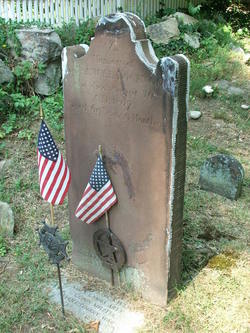Capt. Samuel Lockwood at War
Samuel Lockwood (1737–1807, gravestone shown here courtesy of Find a Grave) of Greenwich, Connecticut, became a second lieutenant in the Continental Army in April 1775.
That fall, he joined Gen. Richard Montgomery’s invasion of Canada. On 5 November Lockwood’s commanders made him an assistant engineer with the rank of captain. The Continental Congress never recognized that rank but later voted to pay Lockwood a year’s salary as an engineer.
Lt. Lockwood’s specialty was really maneuvers on the water. He reconnoitered ahead of the army by boat during the march north and helped to capture eleven Crown vessels and Gen. Richard Prescott at Sorel.
The Battle of Québec didn’t work out so well for Lockwood, however. He was wounded, captured, and not released on parole until late in 1776.
As soon as Lockwood was formally exchanged in early 1777, the Congress commissioned him as a captain in Col. John Lamb’s artillery regiment. He served two years, resigning in 1779.
Capt. Lockwood was then done with the Continental Army, but he wasn’t done with the war. He remained active in his state’s military. In 1779 he commanded an armed vessel on Long Island Sound, attacking British ships in the Oyster Bay harbor in November.
On 17 Jan 1780, Capt. Samuel Lockwood led “forty volunteers from Greenwich” alongside Capt. Samuel Keeler and an equal number of Connecticut militiamen on a raid into New York. Their target was the home in Morrisania of Lt. Col. Isaac Hetfield, Loyalist commander of the Westchester County militia.
Gen. William Heath reported to New York’s Gov. (and Gen.) George Clinton about the Lockwood and Keeler raid a few days later:
That fall, he joined Gen. Richard Montgomery’s invasion of Canada. On 5 November Lockwood’s commanders made him an assistant engineer with the rank of captain. The Continental Congress never recognized that rank but later voted to pay Lockwood a year’s salary as an engineer.
Lt. Lockwood’s specialty was really maneuvers on the water. He reconnoitered ahead of the army by boat during the march north and helped to capture eleven Crown vessels and Gen. Richard Prescott at Sorel.
The Battle of Québec didn’t work out so well for Lockwood, however. He was wounded, captured, and not released on parole until late in 1776.
As soon as Lockwood was formally exchanged in early 1777, the Congress commissioned him as a captain in Col. John Lamb’s artillery regiment. He served two years, resigning in 1779.
Capt. Lockwood was then done with the Continental Army, but he wasn’t done with the war. He remained active in his state’s military. In 1779 he commanded an armed vessel on Long Island Sound, attacking British ships in the Oyster Bay harbor in November.
On 17 Jan 1780, Capt. Samuel Lockwood led “forty volunteers from Greenwich” alongside Capt. Samuel Keeler and an equal number of Connecticut militiamen on a raid into New York. Their target was the home in Morrisania of Lt. Col. Isaac Hetfield, Loyalist commander of the Westchester County militia.
Gen. William Heath reported to New York’s Gov. (and Gen.) George Clinton about the Lockwood and Keeler raid a few days later:
they arrived at the place a little after one the next morning, attacked the picket, killed 3 and drove the others in, march’d to the House where Hatfield was, who, with his men took to the chambers [i.e., bedrooms] and kept up a fire down stairs and out at the windows; the militia behaved with great Bravery, call’d to Hatfield to Surrender or they would Set fire to the House…TOMORROW: The view from inside Hatfield’s house.


1 comment:
Thanks for writing this. Captain Samuel Keeler is my ancestor, and Lockwood is buried in the Old Burial Ground on Tomac Ave in Old Greenwich. He was, to put it mildly, instrumental in the American War for Independence.
Post a Comment